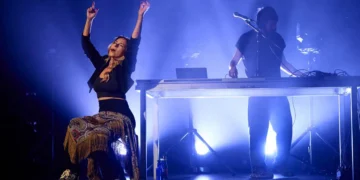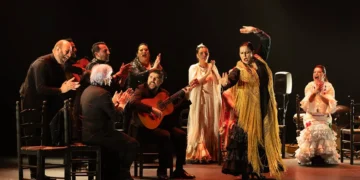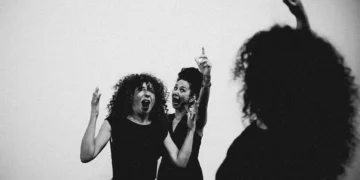|
Celia Morales, Rocío Márquez |
||||||
|
Special XIII Festival de Jerez 2009 – Reviews / News / Photos Text: Estela Zatania / Photos: Ana Palma Photo gallery Celia Morales, Rocío Márquez Many years ago, a young girl gave up playing the guitar because her teacher, Mario Escudero, told her women don’t become flamenco guitarists because they don’t have the necessary strength. Years later, Juan Maya “Marote”, one of the guitarists who got the most dynamic sound from a guitar, taught me that it’s not physical strength, but how you make contact with the strings to make them vibrate with maximum brilliance, sometimes, scarcely grazing the surface. Fast forward to 2009, and the organization of the Festival de Jerez has managed to schedule four female guitarists, each with her own recital, to showcase the new generation which is committed to demonstrating that a woman can have something to say on guitar without the need to do body-building. In fact, at this stage of the game, it makes little sense to consider the gender of the person managing the six strings, a purely circumstantial piece of information. Celia Morales, from Antequera, disciple of Manolo Sanlúcar, has devoted many years of her life to the difficult study of guitar. With a wide repertoire, she also has the admirable virtue of composing music of her own, such as the solea “Enrique el Mellizo” based on the soleá de Cádiz, just as the name indicates. In alegrías, it’s nice to hear her spare use of harmony. She interprets zapateado, a challenge for any maestro of the guitarra, and bulerías, with great musicality, closes out her performance. The second part of this shared recital was given over to young singer Rocío Márquez, recent winner of the coveted Lámpara Minera of the La Unión contest. An extremely precious and delicate delivery is the calling card of this lovely girl from Huelva. Sounds of Chacón and Vallejo counsel her melismatic arabesques, and the sweetness of her voice is a different path from the usual, another way of conjuring up emotion. The young lady has a complete repertoire: malagueña with abandolao, canción por bulería, soleá, tangos, minera, cantiñas, fandangos and bulerías is the varied platter she offered. The fiesta finale brought the odd combination of Farruquito-style dance from one of her backup musicians, with the exquisite delicacy of Márquez’ singing. When you think of it, that’s the singing style and dance style that are most popular nowadays. María Pagés “Autorretrato” Dance: María Pagés. Corps de ballet: María Morales, Sonia Fernández, Isabel Rodríguez, Anabel Veloso, Emilio Herrera, José Barrios, José Antonio Jurado, Alberto Ruíz. Cante: Ana Ramón, Ismael de la Rosa. Guitar: José Carrillo “Fyty”, Isaac Muñoz. Percussion: Chema Uriarte, Paco Vega. Cello: Batio Hangonyi. Choreography: María Pagés. In dance, women’s dominance is today a given: the holy trinity Pagés-Yerbabuena-Baras is what unquestionably runs the box offices of the planet as far as flamenco dance goes. The common denominator is the large format, a story to tell and the combination of classic and contemporary elements. It’s a formula that seems to work. “Autorretrato” is a relatively discreet piece of work for this performer, normally given over to extravagance. As the title ‘Self-portrait’ indicates, there is a certain autobiographical intention to look in the mirror and reveal herself before the audience. As in everything Pagés does, there is a very high level in the technical details. The lighting is noteworthy: Pau Sullana who designed the illumination has managed the dramatic black flamencos always want to use, without making the audience strain to see the dancers, nor are we conscious of spotlights. Some effects, such as the mirror that follows María around the stage, and the illusion of frames that enclose living portraits, are very effective. The chufla por tanguillo Pagés does is a delight, and the corps de ballet is among the best disciplined in the business. Also noteworthy is the rich honeyed voice of singer Ana Ramón who is a regular in this company. María Pagés’ style is based on the serpentine movement of arms and torso, and it can become tiresome, but she is a resourceful woman and has thousands of unconditional fans all over the world. “Autorretrato”, which debuted last year in Tokyo, was awarded the Giraldillo of the Bienal de Sevilla for best show of that lengthy festival. Rosario Toledo, David Palomar “Del primer paso” Rosario Toledo and David Palomar show signs of becoming a stage team. For the second time in less than a year, these young performers from Cádiz have pooled their talents to conjure up good vibrations with a shared open perspective. “Del Primer Paso” doesn’t reach the sublime heights of “Aires de Cádiz”, the perfect work the couple took to the Mont-de-Marsan festival last year, but the chemistry is in place, a kind of communication that reaches out to the audience, making for a different sort of show, with reduced format, based on intimism and the rejection of opulence. With this kind of quality, no window-dressing is necessary. Rosario and David are well-prepared and have big personalities. She, with her amusing doll-face, her fascinating arms and mischievous good humor. He, with his strong flexible voice, his stage presence and talent for dance. Add the fine young guitarist Daniel Méndez, and the recipe is irresistible. The pretext is a light-hearted whirlwind journey through the history of dance, from the first non-descript arm movements, passing through folk verdiales, the inevitable spoofing of tablao dancing, taking us right up to the fine alegrías interpreted with all the Cádiz feeling you’d expect from these two, and traditional cante included. Overall, a contemporary perspective that never fails to draw on the past, and which was very well-received by the full house at the Sala la Compañía. Special XIII Festival de Jerez 2009 – Reviews / News / Photos Text: Estela Zatania / Photos: Ana Palma Photo gallery |
Descubre más desde Revista DeFlamenco.com
Suscríbete y recibe las últimas entradas en tu correo electrónico.


 XIII FESTIVAL DE JEREZ 2009
XIII FESTIVAL DE JEREZ 2009 




























